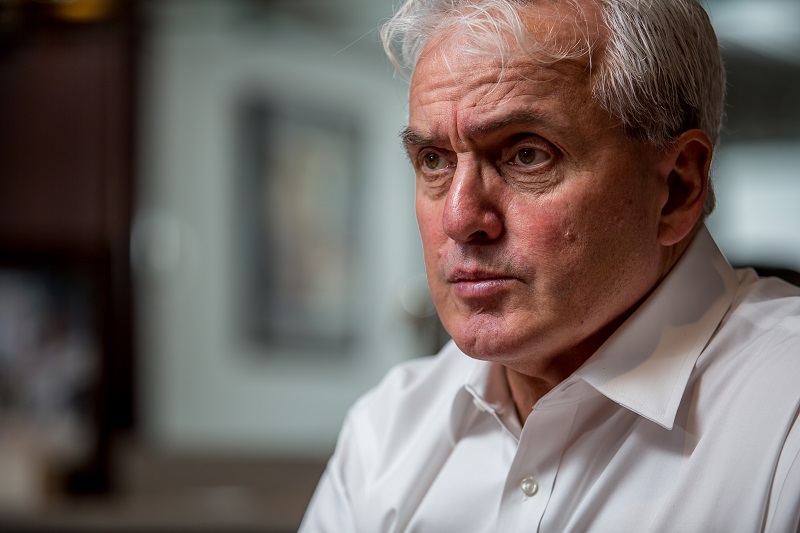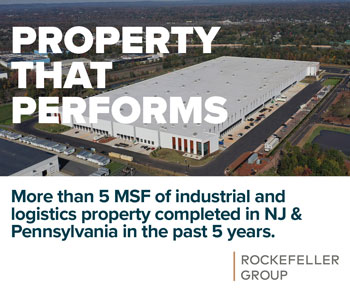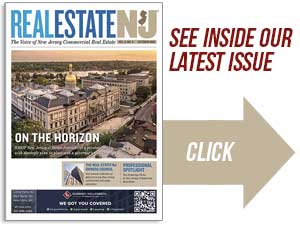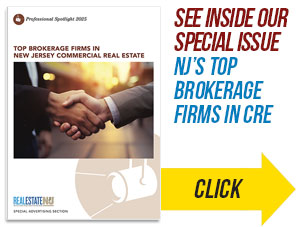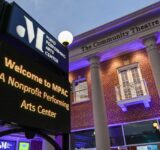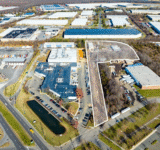Tom Troy, president of Sharbell Development Corp., has been with the firm since 1987 and has helped spearhead its development of the landmark Washington Town Center project in Robbinsville. — Photo by Aaron Houston for Real Estate NJ
By Joshua Burd
It’s been more than 20 years since the first shovel hit the ground, but Tom Troy hasn’t lost sight of what helped launch the landmark Washington Town Center project in Robbinsville.
From the start, he said, the town’s governing body has been cooperative and open-minded.
“The people that were in power at the time, in the late ’90s, really wanted to do something different with this property,” said Troy, the president of Sharbell Development Corp., which has spearheaded the project. “They didn’t want to turn it into another single-family subdivision, which is what the underlying zoning was for. So they were forward-thinking enough and we were fortunate enough to get involved with them at that time to work in a very collaborative way, to bring it through the design, the regulatory issues, the permitting issues — and I think a lot of the success is due to having a collaborative partner on the other side.
“As you know, that doesn’t always happen in New Jersey. Quite often it’s the other way around.”
Two decades later, the results speak for themselves. The 140-acre Washington Town Center is an acclaimed model of public-private coordination in New Jersey, having yielded a new downtown from whole cloth with a broad mix of housing types, commercial space, parks and other community amenities, all with immediate access to Route 33.
Sharbell is now entering the final stages of the project, which now has roughly 1,000 residential units and 256,000 square feet of retail and office space, as it ramps up its pipeline elsewhere in New Jersey. It’s also looking beyond its home state with the hopes of drawing from its experience at Washington Town Center. To that end, the firm is spearheading the development of roughly 100 acres near Charleston, South Carolina, where it’s focused on building out a new downtown that will serve as the hub of an emerging community.
“We see this opportunity as something that really fits well within our footprint, particularly given the last 20 years’ experience that we’ve had with the Robbinsville town center here and even to a certain degree with what we did in Plainsboro,” Troy said, referring to another one of Sharbell’s major mixed-use projects. He added: “There’s a lot of that connectivity that goes beyond just what it is that we’re developing and connects back to the fabric of the town.”
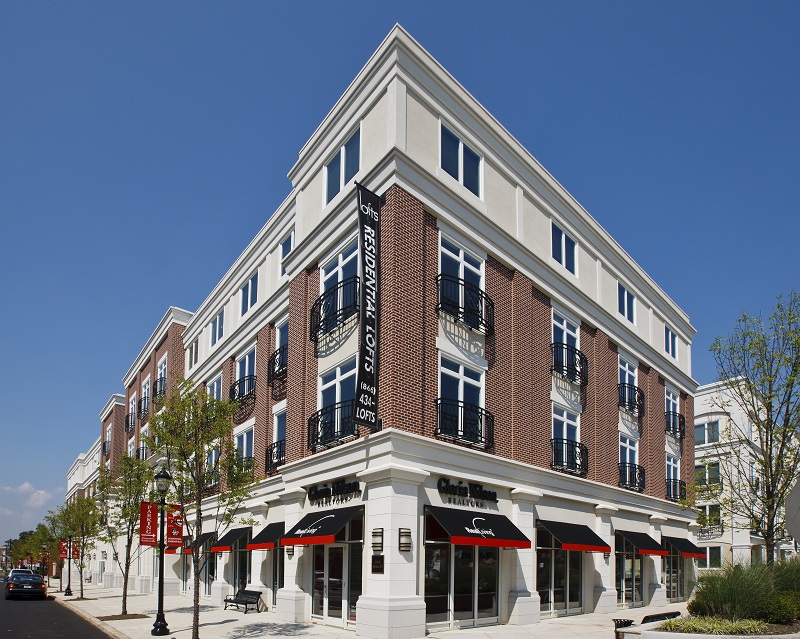
Developing a new town center over more than 20 years has been a case study in patience, collaboration and flexibility, but it all began with the right location. As Troy noted, the Washington Town Center site benefits from frontage on a very busy state highway, Route 33, at a busy intersection with a county roadway. That created the core around which Sharbell could build, while incorporating varying intensities and uses as it built out the 140-acre site.
The developer first broke ground in early 2000 and went nearly a decade with strong sales across different housing types, which included single-family dwellings, townhomes and duplexes. Troy believes that the site would have continued to attract buyers even after the market crashed in 2008, but Sharbell by that time had built out that component of the project.
The firm then turned its attention to mixed-use buildings with multifamily units above ground-floor retail space. In doing so, he said “we built the buildings at a slower pace, one at a time, rather than doing a whole block (with) three or four buildings at a time.” That allowed Sharbell to “meter the absorption with the downturn, with still some demand there” as it transitioned its focus to rentals.
During that time, the plan also evolved from what Troy described as “a somewhat less ambitious commercial core.”
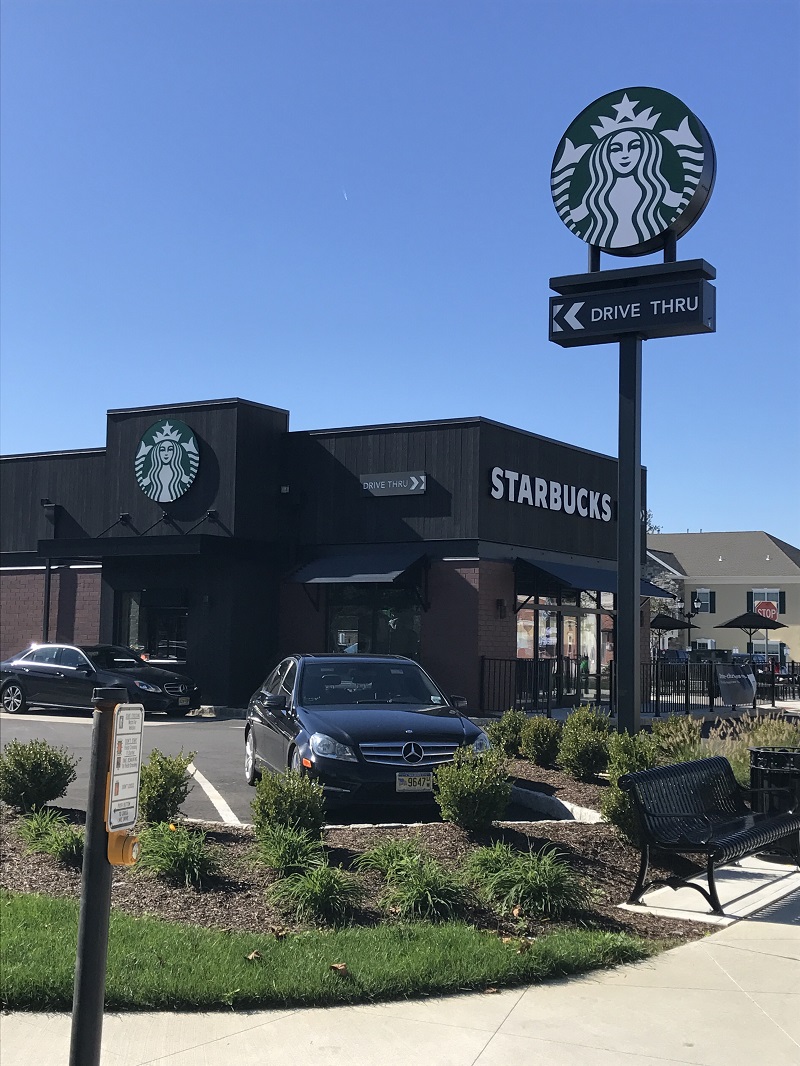
“The original densities were far less than what we’ve got built out there now,” said Troy, who served as president of the New Jersey Builders Association in 2018. “But once we got started and realized that there really was demand, not just for the commercial spaces, but for the multifamily spaces above that … we were fortunate enough to go back to the town over a 10- to 12-year period and rationalize the addition of more and different types of uses.
“The plan originally did not contemplate single-user pads, but now, I think to everybody’s credit, we’ve got a Starbucks, we’ve got a Rite Aid, we’ve got a couple of banks, we’ve got a few other uses that would fit right into the fabric and meet the architectural standards,” he continued. “So having flexible parties on both sides of the table yields better results than when you have to kind of try and push something.
“And we’ve had a very long view of how this project wants to feel and finish.”
Today, Washington Town Center is home to a mix of housing types and densities, along with a diversity of commercial spaces, from suites that sit beneath apartments to freestanding pad sites. Sharbell to date has built 99,000 square feet of retail space, with the capacity to add another 28,000 square feet. What’s more, the property features 157,000 square feet of office space and has another 20,000 square feet of unbuilt space available.
Sharbell, meantime, has made its presence felt elsewhere in central New Jersey, as it has evolved over more than 35 years from a single-family homebuilder to one that does varied housing types and mixed-use destinations. In Plainsboro, the firm spent 2005 to 2017 building out the Village Center, which Troy calls “a mini-version” of the Robbinsville project. The site features 52 for-sale homes and eight rental apartments, along with 55,000 square feet of retail space, most of which sits below upper-level office space within a walkable, mixed-use setting.
The developer has also built a portfolio of active adult communities in Hamilton, starting in 1997 with a 418-unit, for-sale project across from Robert Wood Johnson University Hospital Hamilton. It would build another 482 units over the next two decades, which included a transition to rentals for its third project, and is now eyeing plans for a fourth that would add another 122 duplexes and townhomes to its age-restricted portfolio in the township.
“Hamilton had a very high population of active adults that were really underserved in terms of product,” said Troy, who has been with Sharbell since 1987. “So we found ourselves again, very fortunate in terms of the demand being there.”
The developer has evolved its product type as residents’ tastes have changed, he added. More recently, renters have sought somewhat larger, duplex-style units in exchange for slightly smaller amenity spaces.
“People are coming out of bigger homes, so they don’t want to go into a multifamily unit,” Troy said. “They still need basements, they need two-car garages, and you’re starting to see that with some of the other competitors in our marketplace that are offering similar product.”
Additionally, Sharbell has major projects in development in Montgomery, where it’s redeveloping a 60-year-old former corporate campus within the township’s Skillman section. Plans for Montgomery Crossing call for 107 luxury townhomes and 40 condominiums within one building, along with an 86-unit affordable housing property built by PIHRL, all within walking distance of the township’s downtown core.
The PIHRL project should be completed by late 2020 or early 2021, Troy said. For its part, Sharbell is now underway with site improvements and building construction in phase one of Montgomery Crossing, with 15 sales closed as of mid-April and first unit deliveries slated for September.
Such projects are a sign that the firm is still a believer in for-sale offerings, but increasingly in the form of townhomes as opposed to single-family lots.
“Townhomes are becoming a big part of our volume,” Troy said.
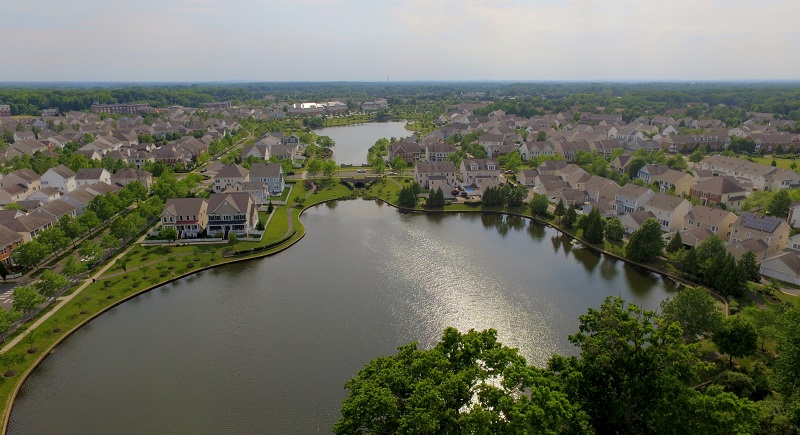
As Sharbell was growing its portfolio in Robbinsville, Hamilton and elsewhere in the early 2000s, the firm began to seek opportunities outside New Jersey with an eye toward “opportunities that had a little bit more runway to them,” Troy said. To that end, it looked to the South in markets such as Raleigh, Durham and Chapel Hill in North Carolina and southeastern Florida, before ultimately turning its focus to greater Charleston, South Carolina.
Around 2013, he said the firm recognized the “tremendous growth dynamic” in the area, citing its evolution beyond what was once a tourism- and retirement-driven economy. He pointed to major manufacturing operations by Boeing, Volvo and Mercedes-Benz, along with the growth of the University of South Carolina and highway accessibility on Interstate 26. Sharbell now has its sights set on the town of Summerville, about 25 minutes from downtown Charleston, where it controls nearly 100 acres within an emerging enclave known as Nexton. Developers in recent years have already built several thousand units of housing in the surrounding area, Troy said, but Sharbell has what he believes is the core of the community and a location that is ripe for a denser, downtown-style development.
The firm expects to parcel out much of the land to other builders and focus on mixed-use projects that would yield around 200 residential units and 100,000 square feet of office and retail space. Those projects will serve as the focal point for additional housing and commercial space, which Sharbell is master-planning in an effort that includes fully completed roadways and shared drainage.
“It’s a really good opportunity to apply what we’ve learned here in Robbinsville over the last 20 years in terms of how to assemble the right types of uses, but also the right intensities of uses to achieve a successful mixed-use downtown, for lack of a better term,” Troy said. “I don’t want to say it’s easier, but it’s different than going into an urban context or a more heavily developed context and then redeveloping a piece, because all of the other parts and pieces and compatible uses are there.
“When you’re starting with a green field, if you will, or a place that’s going to become a downtown, you really have to be careful about how you incorporate the different types of uses to coincide with the intensity of the residential development and the needs of those residential users into the recipe and the finished product for a mixed-use core.”
Healthy options
A long with its multi-decade portfolio of residential construction, Sharbell Development Corp. has amassed its share of commercial property, both inside and outside of its mixed-use projects.
In recent years, medical users have become key to filling those spaces. “When we first started our ground floor retail, our storefronts … the last thing we thought we were going to get were medical service providers,” Troy said of the Washington Town Center project in Robbinsville.
Yet health care and medical tenants are among the site’s most prominent commercial users.
“It’s interesting to see that what you would normally think of as being straight retail in a downtown environment is becoming another outlet for some form of medical service provider,” Troy continued, later adding: “So those kinds of changes are encouraging when you have that type of space. … I think it reinforces the thought of a downtown. You can pretty much get everything you need there.”
He noted that major changes in health care, including consolidation and competition among hospitals, have yielded new demands for medical facilities. Sharbell’s main geographic footprint is home to three major health networks — Penn Medicine Princeton Health, Capital Health and RWJBarnabas Health — which have all taken space from the firm either directly or through affiliated practices.
It has become clear that those providers see the area as a growth market.
“I think we all know that the demand for residential in New Jersey, while it’s still here, it’s somewhat spotty,” Troy said. “And I think we’re all kind of cautious about just how much volume we can anticipate coming from any one area, but I think (hospital systems) see not so much the new potential development, but the maturing of the markets, the people that are here, and they see opportunities.”

